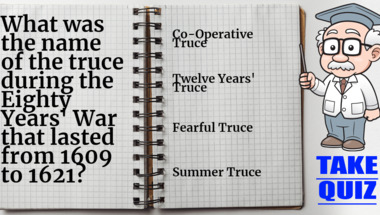

Will you even get 5 questions right?

If you want, please tell us your score in the..

Click here to have fun

10 famous brands. Can you answer most of them..

10 questions to test your knowledge

How many songs do you know?

How high can you score?

10 questions to answer

Let's see how smart you really are!

10 questions about geography

10 questions to test your knowledge

A score above 4/10 is amazing

What do you remember?

We wrote 10 questions in mixed categories

You won't get close to 10/10 in this quiz

Are you up for a quiz?

10

How many correct will you get?

10 entertaining geography questions

Let's see how smart you really are!

10 songs to guess

How will you do in this general knowledge qui..

10 questions to answer

How smart are you?

10 mixed questions

How many of them will you answer correctly?

10 quite hard questions

10 mixed up questions in a range of categorie..

10 questions

10 fun questions

Do you know all the best selling music albums..

10 trivia questions of a general nature from ..

Let us know your score in the comments

How many correct will you get?

10 questions

Please tell me your score in the comments

10 questions to test your knowledge

..ooOO 10 questions OOoo..

Are you game?

How many songs can you guess?

10 questions in mixed categories

Can you name the artists?

Trivia fun

Mixed category quiz

Expert questions for developed minds

Let's test your trivia skills!

How many songs do you know?

Are you ready?

How many correct will you get?

10 questions to test your knowledge

10 quite hard questions

We wrote 10 questions in mixed categories

10 Smart Questions

Share if you get more than 3 correct

10 random questions

10 questions for you to have fun with

10 Absolutely Impossible Questions

10 Questions That Will Challenge You!

10 questions

10 questions to test your knowledge

How many correct will you get?

10 questions to answer

Can you answer 7/10 of these questions?

How many correct answers will you get?

10 question quiz

Tell us your score in the comment section bel..

10 questions

Are you 60 years or older?

10 questions

Is your IQ high enough for these questions?

Let us know your score in the comments

10 questions to test your knowledge

Can you recall how many of these slang words?

10 interesting questions

How many of these old jobs do you remember?

You are probably going to fail most questions

How will you do in this general knowledge qui..

10 mixed songs to guess

Can you score 7 or higher?

10 questions

10 mixed questions to have fun with

10 questions

Are you up for a quiz?

>> 10 mixed questions <<

I made a quiz for you! :)

How many correct answers will you get?

10 fun questions

10 Impossible Questions

Home Cook & Pro Chef?

Try out this fun quick quiz

Play it with your loved one

10 fun questions

Are you smart enough for this one?

Trivia quiz for experts

Ten amazing questions

Let's see how smart you really are!

10 questions about different songs

10 questions to test your knowledge

Here are 10 thought-provoking questions to po..

10 songs to guess

10 mixed questions

10 hard trivia questions

Click here to start!

How many songs do you know?

Is it possible for you to achieve a perfect s..

10 home chef questions

10 questions about science

What is the number of accurate responses you ..

10 questions in mixed categories

10 songs to guess

Tell us your result in the comments!

10 questions to test your knowledge

How many of them will you answer correctly?

10 questions lined up

10 fun questions

Can you score 6 or higher?

10 home chef questions

Can you score 8/10?

10 questions to test your knowledge

The last two questions will be your nemesis! ..

Trivia questions are not only fun but also offer a broad window into the world’s culture, history, and fascinating facts. Let’s take a deep dive into ten intriguing trivia questions, exploring their backgrounds and the wealth of information they uncover.
1. What animal builds lodges, dams up rivers and has large front teeth for gnawing?
The answer to this classic question is the beaver. Beavers are remarkable creatures known for their engineering prowess. With their strong, ever-growing incisors, beavers gnaw on wood to construct intricate lodges, which serve as their homes, and dams, which create ponds providing safety from predators. These animals play a crucial role in their ecosystems, as their activities can transform landscapes, create wetlands, and benefit a variety of other species. Beavers’ teeth are a particular marvel, coated with iron-rich enamel that gives them their distinctive orange hue and allows them to chew through even the toughest trees. Their lodges are built using branches, mud, and vegetation, ensuring warmth and protection during harsh winters.
2. Which word rhymes with joy?
This question brings us into the realm of language and phonetics. The word boy rhymes with joy, sharing the same ending sound. Rhyming has been an essential element in poetry, music, and children’s literature for centuries. It not only makes language more musical but also aids in memory and learning. Rhymes are found everywhere, from nursery rhymes to hit songs, and they play a crucial role in the linguistic development of children. Words like toy, soy, and ploy also rhyme with joy, showcasing the richness of the English language.
3. Who performed Candle in the Wind at Diana's funeral in Westminster Abbey?
The poignant performance of Candle in the Wind at Princess Diana’s funeral on September 6, 1997, was delivered by Elton John. Originally written in 1973 as a tribute to Marilyn Monroe, the song was reworked with new lyrics by lyricist Bernie Taupin to honor Diana, Princess of Wales, after her tragic death. Elton John’s emotional performance touched millions worldwide and became one of the best-selling singles of all time. The song’s heartfelt lyrics and somber melody captured the public’s grief and admiration for Diana, making it a historic moment in both music and royal history.
4. What are important qualities in outerwear scarves?
Scarves are more than just a fashion statement; they are practical accessories that provide warmth, comfort, and style. When selecting an outerwear scarf, important qualities include material, warmth, breathability, softness, size, and durability. Wool and cashmere scarves offer superior insulation for cold climates, while cotton or silk are better for milder weather. A good scarf should be soft against the skin, large enough to wrap comfortably, and durable enough to withstand regular use. Breathability is also essential to ensure comfort without overheating. Additionally, scarves come in various colors and patterns, making them versatile accessories that can complement any outfit.
5. Which politician described Russia in a radio broadcast as “a riddle, wrapped in a mystery, inside an enigma”?
This evocative phrase about Russia was famously uttered by Winston Churchill during a radio broadcast in October 1939. At the time, Europe was plunged into uncertainty at the onset of World War II, and Churchill was reflecting on the unpredictable nature of Russian foreign policy. The full quote is: I cannot forecast to you the action of Russia. It is a riddle, wrapped in a mystery, inside an enigma; but perhaps there is a key. That key is Russian national interest. Churchill’s words have since become iconic, often cited when discussing the complexities of Russian politics and international relations. His mastery of language and insight into global affairs made him one of the most memorable leaders of the twentieth century.
6. On whose U.S. TV show did The Beatles first appear in person?
The Beatles made their landmark American television debut on The Ed Sullivan Show on February 9, 1964. This event is widely regarded as a turning point in music history, heralding the start of the British Invasion. More than 70 million viewers tuned in, marking one of the largest television audiences at the time. The Beatles’ appearance not only launched their phenomenal career in the United States but also transformed popular music and youth culture. The Ed Sullivan Show itself was a variety program that introduced countless acts to American audiences, but none as influential as The Beatles. Their performance is still celebrated today as a milestone in entertainment lore.
7. Susan B. Anthony is known best as what?
Susan B. Anthony is best known as a pioneering leader in the women’s suffrage movement. Throughout the 19th century, Anthony devoted her life to securing voting rights for women in the United States. She played a pivotal role in organizing campaigns, delivering speeches, and collaborating with other activists like Elizabeth Cady Stanton. Anthony’s tireless efforts contributed to the eventual passage of the 19th Amendment in 1920, granting women the right to vote. Her legacy endures, symbolizing equality, justice, and the power of activism. In honor of her contributions, the U.S. Mint issued the Susan B. Anthony dollar coin, making her one of the most prominent historical figures in the fight for civil rights.
8. What tragedy took place on April 15, 1912?
One of the most infamous disasters in maritime history occurred on April 15, 1912, when the RMS Titanic sank in the North Atlantic Ocean after striking an iceberg. The Titanic, hailed as the unsinkable ship, was on its maiden voyage from Southampton to New York City when it hit the iceberg late on April 14. In the early hours of April 15, the ship broke apart and sank, resulting in the deaths of over 1,500 passengers and crew. The tragedy led to sweeping changes in maritime safety regulations and inspired countless books, films, and studies. The sinking of the Titanic remains a powerful reminder of human vulnerability and the importance of safety at sea.
9. If a jet cruises at 575 mph, how far will it go in 12 hours?
This question requires a bit of simple math. If a jet travels at a steady speed of 575 miles per hour for 12 hours, the total distance covered is calculated by multiplying speed by time:
Distance = Speed × Time = 575 mph × 12 hours = 6,900 miles
This impressive distance highlights the power of modern aviation, making it possible to traverse continents or even cross entire oceans in a single flight. Such speeds are typical for commercial jets like the Boeing 777 or Airbus A350 during long-haul flights, connecting people and cultures around the globe.
10. Who wrote Rock and Roll Never Forgets?
The classic rock anthem Rock and Roll Never Forgets was written by Bob Seger. Released in 1976 as part of the album Night Moves, the song reflects on the enduring spirit of rock music and its lasting impact on listeners, regardless of age. Bob Seger’s storytelling and energetic style have made him a beloved figure in American rock history. The song remains a staple on classic rock radio and is celebrated for its nostalgic look at the power of music to connect generations and evoke memories. Seger’s work, including Rock and Roll Never Forgets, has influenced countless artists and continues to inspire fans worldwide.
These ten trivia questions cover a fascinating range of topics, from natural wonders and language quirks to iconic cultural moments and pivotal historical events. They remind us how much there is to learn and appreciate about the world around us, and how trivia can spark curiosity, conversation, and deeper exploration into the stories that shape our lives.